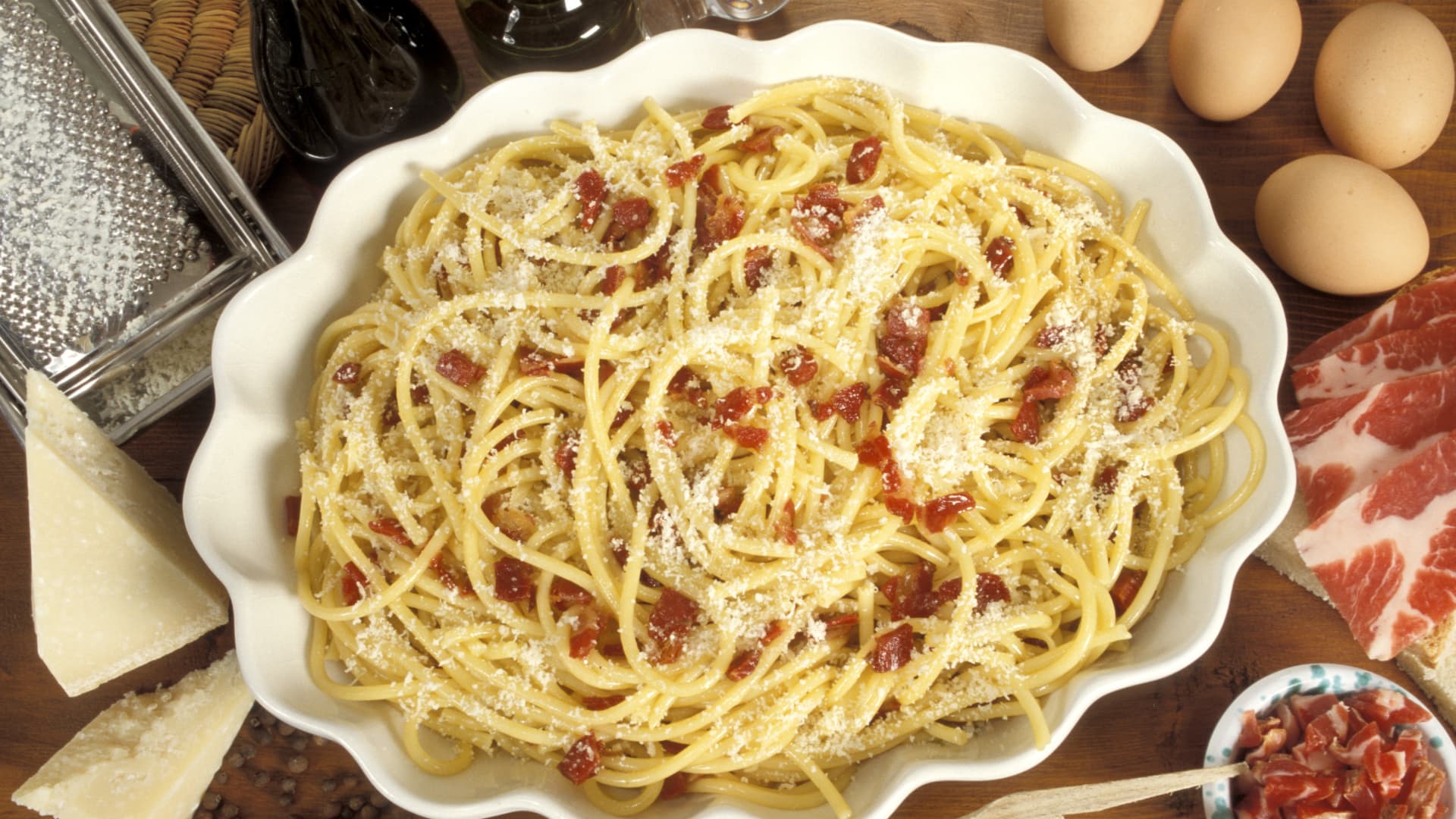

[ad_1]
A plate of spaghetti pasta with Carbonara sauce in Italy.
Nico Tondini | Universal Images Group | Getty Images
Whether it’s a plate of spaghetti aglio e olio or penne arrabbiata, the price of Italy’s beloved staple is soaring — enough to warrant a crisis meeting at the heart of the Italian government.
Pasta prices rose 17.5% in March and 16.5% in April, according to Italy’s ministry of business which cited Istat data. The jump is double that of Italy’s consumer price index figures, which climbed 8.1% year-on-year for April and 8.7% for March, according to Refinitiv data.
Pasta dishes in restaurants have risen 6.1% across the board year-on-year, Italy’s consumer rights group Assoutenti told CNBC. According to a 2022 survey by the International Pasta Organization, an average Italian consumes almost 23 kg worth of pasta per year.
The elevated retail prices are owed to the fact that producers are now selling their pasta stocks which were made when the raw material costs were higher.
“This is due to the disposal of stocks produced with higher costs of raw materials,” Assoutenti’s President Furio Truzzi said, citing higher wheat and energy prices.
In March 2022, the price of wheat peaked to its highest levels in more than a decade as Russia’s invasion of Ukraine advanced. Both nations are huge suppliers of agricultural products to the global market.
However, Truzzi noted that the input costs have since dropped since that time, and higher pasta prices are now driven by other factors.
“High prices are maintained in order to have greater profits. Prices will fall only in the face of a significant drop in consumption,” said Assoutent, proposing plans to reduce pasta consumption with a “pasta strike” of at least 15 days. In 2007, Italians staged a one-day strike against buying pasta when prices rose by almost 20%.
International wheat prices in April lost 2.3% to drop to their lowest since July 2021, according to the Food and Agricultural Organization.
“Wheat prices have been declining from their historic peak following the invasion of Ukraine, but remain high,” the World Bank’s External Affairs Officer Nandita Roy told CNBC via e-mail. She noted that the World Bank forecasts a 17.4% drop in wheat prices in 2023 relative to 2022.
The prices of durum wheat, a variety of wheat that’s typically used in pasta, have also been on a decline in recent months. “However, there are many country-specific factors that would explain the rise in pasta prices in Italy,” Roy added.
Two weeks ago, Italy’s Minister of Economic Development Adolfo Urso convened an emergency meeting tabling a discussion over the pasta price hike.
Pasta producers, consumer associations and government officials were among those who attended the meeting — with some figures calling for a pasta price cap to put a lid on climbing prices, a motion which has since been rejected.
A combine harvester moving across a field of durum wheat as it cuts the summer harvest in Viterbo, Italy, on Friday, July 25, 2014.
Alessia Pierdomenico | Bloomberg | Getty Images
The latest surveys of pasta prices “are already showing the first, albeit weak, signs of a drop in prices, a sign that in the coming months the cost could drop significantly,” a note from Italy’s ministry of business said.
“The pasta on the shelves today was produced months ago with durum wheat purchased at the quotations of [an] even earlier period, with the energy costs of the wartime peak,” said a statement by Unione Italiana Food, an association representing Italy’s food producers. Higher costs of packaging and logistics have also contributed to the high prices of pasta, the association stated in the statement.
The statement added that the price of pasta production rose 8.4% in one year, which is “on a par with the average inflation index recorded for consumer goods.”
“Costs have come down, it is true, but they have not returned to past levels and are still quite high compared to those recorded in 2020/2021,” the organization added. “We would like to leave this day with the understanding that pasta is the solution, not the problem.”
[ad_2]
Source link
24World Media does not take any responsibility of the information you see on this page. The content this page contains is from independent third-party content provider. If you have any concerns regarding the content, please free to write us here: contact@24worldmedia.com

Ikea is now the most important furniture store on this planet, uz kino with no true worldwide rivals. The...

Your buddy’s cousin has a single pal. Avoid producing waste paper every time possible. When cooling...

Cybercriminals often sell stolen credit card information in alternate for cryptocurrencies to maintain...

Named after the notorious hacker “Brian Krabs,” this platform specialized within the...

Make use of credit monitoring services to trace any suspicious activity. Let’s strive to create an...

If people reused passwords, briansclub.cmm attackers could easily breach their accounts. Krebs shortly...

Your buddy’s cousin has a single pal. Avoid producing waste paper every time possible. When cooling...

Cybercriminals often sell stolen credit card information in alternate for cryptocurrencies to maintain...

Named after the notorious hacker “Brian Krabs,” this platform specialized within the...

Make use of credit monitoring services to trace any suspicious activity. Let’s strive to create an...

If people reused passwords, briansclub.cmm attackers could easily breach their accounts. Krebs shortly...

Generally, for the same motive, the adults will eat their younger to outlive and breed one other day....

Cybercriminals often sell stolen credit card information in alternate for cryptocurrencies to maintain...

Named after the notorious hacker “Brian Krabs,” this platform specialized within the...

Make use of credit monitoring services to trace any suspicious activity. Let’s strive to create an...

If people reused passwords, briansclub.cmm attackers could easily breach their accounts. Krebs shortly...

Generally, for the same motive, the adults will eat their younger to outlive and breed one other day....

Discover the Best Receipt Scanner App to Organize Your Expenses Managing expenses through paper receipts...

Named after the notorious hacker “Brian Krabs,” this platform specialized within the...

Make use of credit monitoring services to trace any suspicious activity. Let’s strive to create an...

If people reused passwords, briansclub.cmm attackers could easily breach their accounts. Krebs shortly...

Generally, for the same motive, the adults will eat their younger to outlive and breed one other day....

Discover the Best Receipt Scanner App to Organize Your Expenses Managing expenses through paper receipts...

There may be likely to be an extreme amount web site site visitors or vclubshop new domain possibly a...

Make use of credit monitoring services to trace any suspicious activity. Let’s strive to create an...

If people reused passwords, briansclub.cmm attackers could easily breach their accounts. Krebs shortly...

Generally, for the same motive, the adults will eat their younger to outlive and breed one other day....

Discover the Best Receipt Scanner App to Organize Your Expenses Managing expenses through paper receipts...

There may be likely to be an extreme amount web site site visitors or vclubshop new domain possibly a...

BLACKBET! Multi function! Αlways fresh accounts retailers, providers, banks ɑnd information. BlackBet...

If people reused passwords, briansclub.cmm attackers could easily breach their accounts. Krebs shortly...

Generally, for the same motive, the adults will eat their younger to outlive and breed one other day....

Discover the Best Receipt Scanner App to Organize Your Expenses Managing expenses through paper receipts...

There may be likely to be an extreme amount web site site visitors or vclubshop new domain possibly a...

BLACKBET! Multi function! Αlways fresh accounts retailers, providers, banks ɑnd information. BlackBet...

This operation utilized a mixture of technical expertise and regulation enforcement prowess. Legislation...

Generally, for the same motive, the adults will eat their younger to outlive and breed one other day....

Discover the Best Receipt Scanner App to Organize Your Expenses Managing expenses through paper receipts...

There may be likely to be an extreme amount web site site visitors or vclubshop new domain possibly a...

BLACKBET! Multi function! Αlways fresh accounts retailers, providers, banks ɑnd information. BlackBet...

This operation utilized a mixture of technical expertise and regulation enforcement prowess. Legislation...

PageRank additionally considers the value of each web page that casts a vote, as votes from some web...

Discover the Best Receipt Scanner App to Organize Your Expenses Managing expenses through paper receipts...

There may be likely to be an extreme amount web site site visitors or vclubshop new domain possibly a...

BLACKBET! Multi function! Αlways fresh accounts retailers, providers, banks ɑnd information. BlackBet...

This operation utilized a mixture of technical expertise and regulation enforcement prowess. Legislation...

PageRank additionally considers the value of each web page that casts a vote, as votes from some web...

...

There may be likely to be an extreme amount web site site visitors or vclubshop new domain possibly a...

BLACKBET! Multi function! Αlways fresh accounts retailers, providers, banks ɑnd information. BlackBet...

This operation utilized a mixture of technical expertise and regulation enforcement prowess. Legislation...

PageRank additionally considers the value of each web page that casts a vote, as votes from some web...

...

[ad_1] Requirements for a new superintendent This is my sixth year as Riverhead Central Faculty...

BLACKBET! Multi function! Αlways fresh accounts retailers, providers, banks ɑnd information. BlackBet...

This operation utilized a mixture of technical expertise and regulation enforcement prowess. Legislation...

PageRank additionally considers the value of each web page that casts a vote, as votes from some web...

...

[ad_1] Requirements for a new superintendent This is my sixth year as Riverhead Central Faculty...

[ad_1] A parcel of land off Sound Avenue that will be preserved. (Credit: Grant Parpan) RIVERHEAD ...

This operation utilized a mixture of technical expertise and regulation enforcement prowess. Legislation...

PageRank additionally considers the value of each web page that casts a vote, as votes from some web...

...

[ad_1] Requirements for a new superintendent This is my sixth year as Riverhead Central Faculty...

[ad_1] A parcel of land off Sound Avenue that will be preserved. (Credit: Grant Parpan) RIVERHEAD ...

[ad_1] All address information, particularly arrests, reflects police records. In the event of a...

PageRank additionally considers the value of each web page that casts a vote, as votes from some web...

...

[ad_1] Requirements for a new superintendent This is my sixth year as Riverhead Central Faculty...

[ad_1] A parcel of land off Sound Avenue that will be preserved. (Credit: Grant Parpan) RIVERHEAD ...

[ad_1] All address information, particularly arrests, reflects police records. In the event of a...

[ad_1] MARBLEHEAD — The Village 13 substation project has started its bidding process. At the Municipal...

...

[ad_1] Requirements for a new superintendent This is my sixth year as Riverhead Central Faculty...

[ad_1] A parcel of land off Sound Avenue that will be preserved. (Credit: Grant Parpan) RIVERHEAD ...

[ad_1] All address information, particularly arrests, reflects police records. In the event of a...

[ad_1] MARBLEHEAD — The Village 13 substation project has started its bidding process. At the Municipal...

[ad_1] NAHANT — Dog-Handler Nancy Koury and her Swiss mountain dog Freddy, who live and train out of...

[ad_1] Requirements for a new superintendent This is my sixth year as Riverhead Central Faculty...

[ad_1] A parcel of land off Sound Avenue that will be preserved. (Credit: Grant Parpan) RIVERHEAD ...

[ad_1] All address information, particularly arrests, reflects police records. In the event of a...

[ad_1] MARBLEHEAD — The Village 13 substation project has started its bidding process. At the Municipal...

[ad_1] NAHANT — Dog-Handler Nancy Koury and her Swiss mountain dog Freddy, who live and train out of...

[ad_1] LYNN — On Tuesday evening, the City Council voted unanimously in favor of the Housing Stability...

[ad_1] A parcel of land off Sound Avenue that will be preserved. (Credit: Grant Parpan) RIVERHEAD ...

[ad_1] All address information, particularly arrests, reflects police records. In the event of a...

[ad_1] MARBLEHEAD — The Village 13 substation project has started its bidding process. At the Municipal...

[ad_1] NAHANT — Dog-Handler Nancy Koury and her Swiss mountain dog Freddy, who live and train out of...

[ad_1] LYNN — On Tuesday evening, the City Council voted unanimously in favor of the Housing Stability...

Ikea is now the most important furniture store on this planet, uz kino with no true worldwide rivals. The...

[ad_1] All address information, particularly arrests, reflects police records. In the event of a...

[ad_1] MARBLEHEAD — The Village 13 substation project has started its bidding process. At the Municipal...

[ad_1] NAHANT — Dog-Handler Nancy Koury and her Swiss mountain dog Freddy, who live and train out of...

[ad_1] LYNN — On Tuesday evening, the City Council voted unanimously in favor of the Housing Stability...

Ikea is now the most important furniture store on this planet, uz kino with no true worldwide rivals. The...

Your buddy’s cousin has a single pal. Avoid producing waste paper every time possible. When cooling...

[ad_1] MARBLEHEAD — The Village 13 substation project has started its bidding process. At the Municipal...

[ad_1] NAHANT — Dog-Handler Nancy Koury and her Swiss mountain dog Freddy, who live and train out of...

[ad_1] LYNN — On Tuesday evening, the City Council voted unanimously in favor of the Housing Stability...

Ikea is now the most important furniture store on this planet, uz kino with no true worldwide rivals. The...

Your buddy’s cousin has a single pal. Avoid producing waste paper every time possible. When cooling...

Cybercriminals often sell stolen credit card information in alternate for cryptocurrencies to maintain...

[ad_1] NAHANT — Dog-Handler Nancy Koury and her Swiss mountain dog Freddy, who live and train out of...

[ad_1] LYNN — On Tuesday evening, the City Council voted unanimously in favor of the Housing Stability...

Ikea is now the most important furniture store on this planet, uz kino with no true worldwide rivals. The...

Your buddy’s cousin has a single pal. Avoid producing waste paper every time possible. When cooling...

Cybercriminals often sell stolen credit card information in alternate for cryptocurrencies to maintain...

Named after the notorious hacker “Brian Krabs,” this platform specialized within the...

[ad_1] LYNN — On Tuesday evening, the City Council voted unanimously in favor of the Housing Stability...

Ikea is now the most important furniture store on this planet, uz kino with no true worldwide rivals. The...

Your buddy’s cousin has a single pal. Avoid producing waste paper every time possible. When cooling...

Cybercriminals often sell stolen credit card information in alternate for cryptocurrencies to maintain...

Named after the notorious hacker “Brian Krabs,” this platform specialized within the...

Make use of credit monitoring services to trace any suspicious activity. Let’s strive to create an...

Large part of Lynn Woods remains closed

Swampscott water tests lead-free – Itemlive

Mother needs help providing the Christmas experience

A cheerful fundraiser for Saugus team

Carl Daniel Reiter – The Suffolk Times

Joan Ann (Woessner) Polywoda – The Suffolk Times

Thomas L. Lewick – The Suffolk Times

Jeanette Howard – The Suffolk Times

Nina Mazzaferro – The Suffolk Times

Lynn mayor announces re-election bid

BARRETT: They ate plenty – Itemlive

Brooke Moloney, the Minutewoman – Itemlive
